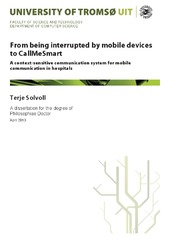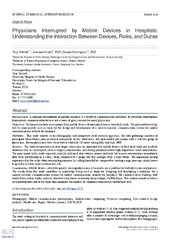| dc.contributor.advisor | Hartvigsen, Gunnar | |
| dc.contributor.author | Solvoll, Terje Geir | |
| dc.date.accessioned | 2013-11-14T14:40:38Z | |
| dc.date.available | 2013-11-14T14:40:38Z | |
| dc.date.issued | 2013-08-22 | |
| dc.description.abstract | Wireless communication infrastructure in hospitals represents a core for information sharing between health care workers. Medical staff’s work situation is highly mobile, and important information is constantly shared between co-workers to provide high quality services to the patients. To be able to communicate at any place and at any time during shifts, physicians carry mobile communication devices, often several devices according to their role and responsibilities. This leads, in many situations, to a number of problems, especially regarding to unnecessary interruptions from these devices. This mainly happens due to the callers not being aware of the situation of the called person, or ignoring the situation and context of their colleagues. Such situations often lead to severe medical consequences, such as medication errors and mistakes during treatment, and should be solved.
To tackle this problem, we used methods from Computer Supported Cooperative Work and Human Computer Interaction, including an ethnographic and interpretive field research approach, where user requirements were elicited using a scenario-based approach. The intention was to learn about the communication situation, include the users in the design and testing process, thus ensuring that the system is designed and developed according to the user’s communication pattern and needs. To develop the CallMeSmart system we used an iterative software engineering approach, denoted Unified Process.
Summarizing, we confirmed that physicians and surgeons are unnecessarily interrupted by mobile communication devices during their daily work, and identified in which situations such interruptions occur. We proved that a context-sensitive system for mobile communication in hospital settings is a suitable solution to manage the balance between a physician’s availability and the interruptions they experience from mobile devices. Under this project, we designed and developed an interruption management system into the existing infrastructure at the Context Laboratory, in our case an Ascom UNITE communication platform, which is similar or compatible with the system used at University Hospital of North Norway. Furthermore, by being able to seamlessly integrate smartphones into the existing infrastructure, we enabled the inclusion of the pagers, messages and alarm systems into the developed context-sensitive system.
The resulting system is called CallMeSmart, a context-sensitive communication system for mobile communication suitable for hospital usage. CallMeSmart is based on an Ascom/trixbox platform, and was designed to reduce interruptions due to wireless phones by improving awareness between the users carrying these devices. The system is designed for hospital environments and reduces interruptions using contextual information related to users, such as: location, availability status and personal commitments. CallMeSmart is intended to meet the new communication needs for health care workers.
The main contribution of this thesis is concentrated around the overall research problem targeted by this Ph.D. project, built up by different research questions. The developed system, CallMeSmart, has been tested by real test users, physicians, and in the Context Laboratory simulating real scenarios. The users gave a positive feedback welcoming the system in their work, so the next step is to test and verify the system in real hospital settings. | en |
| dc.description.doctoraltype | ph.d. | en |
| dc.description.popularabstract | Infrastruktur for trådløs kommunikasjon utgjør en viktig resurs for deling av informasjon mellom helsefagarbeidere. Arbeidssituasjonen til medisinsk personell er meget mobil, og viktig informasjon deles konstant mellom kolleger for å kunne tilby en best mulig pasientbehandling. For å være i stand til å kommunisere med kolleger i løpet av arbeidsdagen, uansett tid og sted, bærer ofte legene med seg en eller flere mobile kommunikasjonsenheter i forhold til deres ansvar og arbeidsrolle. Dette fører ofte til flere problemer, spesielt angående forstyrrelser fra disse enhetene. Dette skjer i hovedsak pga. at den som ringer ofte ikke er klar over arbeidssituasjonen til den de ringer. Slike forstyrrelser er uønsket og kan føre til at legen gjør medisinske feil, feilbehandling eller feilmedisinering, noe som absolutt bør unngås.
Vi har brukt metoder fra “Computer Supported Cooperative Work” og “Human Computer Interaction”, inkludert etnografi og tolkende felt arbeid, hvor brukerkrav ble valgt ved hjelp av scenariobasert testing. Intensjonen var å lære om legers kommunikasjonshverdag og Inkludere brukerne i design og testingsprosessen. Dette for å være sikker på at systemet er designet og utviklet ut fra brukernes kommunikasjonsmønster og behov. For å utvikle CallMeSmart, brukte vi en iterativ programutviklingsprosess kalt, Unified Process.
Oppsummert; vi kan bekrefte at leger og kirurger blir forstyrret unødvendig fra mobile kommunikasjonsenheter I løpet arbeidsdagen. Vi har identifisert og registrert i hvilke situasjoner slike forstyrrelser skjer, og bevist at et kontekst-sensitivt mobilt kommunikasjonssystem vil være en passende løsning for å balansere mellom økt tilgjengelighet og økte forstyrrelser. I prosjektperioden har vi designet og utviklet et «interruption management» system som vi har vært i stand til å integrere i eksisterende infrastruktur, i dette tilfellet Ascom UNITE kommunikasjonsplattform, som er likt eller kompatibel med Universitetssykehuset Nord Norges kommunikasjonssystem. Videre har vi vært i stand til å integrere Smarttelefoner sømløst inn i allerede utviklet løsning og eksisterende infrastruktur, dette inkludert personsøkere og meldings og alarmtjenester.
Det resulterende systemet CallMeSmart, et kontekst-sensitivt kommunikasjonssystem for mobil kommunikasjon på sykehus. CallMeSmart er basert på en Ascom/trixbox Platform og var designet for å redusere forstyrrelser fra mobile kommunikasjonsenheter ved å øke bevisstheten til brukerne. Systemet er designet for sykehusbruk og reduserer forstyrrelser ut fra kontekstuell informasjon om brukerne, som f.eks. lokasjon, tilgjengelighetsstatus og personlige forpliktelser. CallMeSmart er utviklet for å imøtekomme nye kommunikasjonsbehov i helsetjenesten.
Hovedbidraget I denne oppgaven er konsentrert rundt det overordnede forskningsproblemet fokuset på i denne oppgaven, oppbygd av flere underliggende forskningsspørsmål. Det utviklede systemet, CallMeSmart, er blitt testet av potensielle brukere, i dette tilfellet leger og kirurger, hvor det neste steget må bli å teste og verifisere systemet i klinisk sykehusbruk. | en |
| dc.description.sponsorship | This research is supported by the Research Council of Norway, grant no. 176852/S10. | en |
| dc.description | Papers 1,2,4,5,6,7,8,9,10 and 11 of this thesis are not available in Munin: <br/>1. Botsis, T., Solvoll, T., Scholl, J., Hasvold, P. E., and Hartvigsen, G.: 'Context-aware systems for mobile communication in healthcare - A user oriented
approach', WSEAS International Conference on Applied Informatics & Communications (2007), vol 7:69-74, available at <a href=http://dl.acm.org/citation.cfm?id=1348024>http://dl.acm.org/citation.cfm?id=1348024</a> <br/>2. Solvoll, T. and Scholl, J.: 'Strategies to reduce interruptions from mobile communication systems in surgical wards', Journal of Telemedicine and Telecare (2008), vol. 14:389–392, available at <a href=http://dx.doi.org/10.1258/jtt.2008.007015>http://dx.doi.org/10.1258/jtt.2008.007015</a> <br/>4. Solvoll, T.: 'Mobile Communication in Hospitals: What is the Problem?', in Integrated Information and Computing Systems for Natural, Spatial, and Social
Sciences, IGI Global (2013), available at <a href=http://dx.doi.org/10.4018/978-1-4666-2190-9.ch014>http://dx.doi.org/10.4018/978-1-4666-2190-9.ch014</a> <br/>5. Solvoll T, Fasani S, Ravuri AB, Tiemersma A and Hartvigsen G.: 'Evaluation of an Ascom/trixbox system for context sensitive communication in hospitals', Scandinavian Conference on Health Informatics (2010), pp 49-53, available at <a href=http://tapironline.no/fil/vis/555>http://tapironline.no/fil/vis/555</a> <br/>6. Solvoll T, Tiemersma A, Kerbage E, Fasani S, Ravuri AB and Hartvigsen G.: 'Context-sensitive Communication in Hospitals: A User Interface Evaluation and Redesign of Ascom Wireless IP-DECT Phones', eTELEMED Conference(2011), pp. 37-46, available at <a href=http://www.thinkmind.org/index.php?view=article&articleid=etelemed_2011_2_20_40089>http://www.thinkmind.org/index.php?view=article&articleid=etelemed_2011_2_20_40089</a> <br/>7. Talaei-Khoei A, Solvoll T, Ray P and Parameshwaran N.: 'Policy-based Awareness Management (PAM): Case study of a wireless
communication system at a hospital', Journal of Systems and Software(2011), vol.84:1791–1805, available at <a href=http://dx.doi.org/10.1016/j.jss.2011.05.024>http://dx.doi.org/10.1016/j.jss.2011.05.024</a> <br/>8. Talaei-Khoei A, Solvoll T, Ray P and Parameshwaran N.: 'Maintaining awareness using policies; Enabling agents to identify relevance of information', Journal of computer and system sciences (2012), vol. 78:370–391, available at <a href=http://dx.doi.org/10.1016/j.jcss.2011.05.013>http://dx.doi.org/10.1016/j.jcss.2011.05.013</a> <br/>9. Solvoll T, Gironi L and Hartvigsen G.: 'CallMeSmart: An Ascom/trixbox based prototype for context controlled mobile communication in hospitals' (manuscript) <br/>10. Solvoll T, Gironi L, Giordanengo A, and Hartvigsen G.: 'CallMeSmart: A VoIP Softphone on Android Based Mobile Devices Using SIP', eTELEMED Conference (2013), pp. 198-203, available at <a href=http://www.thinkmind.org/index.php?view=article&articleid=etelemed_2013_11_30_40325>http://www.thinkmind.org/index.php?view=article&articleid=etelemed_2013_11_30_40325</a> <br/>11. Talsma, B. G., Solvoll T, and Hartvigsen G.: 'Interruption management for hospital communication systems: A user requirements
specification' (manuscript) | en |
| dc.identifier.isbn | 978-82-8236-101-9 | |
| dc.identifier.uri | https://hdl.handle.net/10037/5510 | |
| dc.identifier.urn | URN:NBN:no-uit_munin_5207 | |
| dc.language.iso | eng | en |
| dc.publisher | Universitetet i Tromsø | en |
| dc.publisher | University of Tromsø | en |
| dc.rights.accessRights | openAccess | |
| dc.rights.holder | Copyright 2013 The Author(s) | |
| dc.rights.uri | https://creativecommons.org/licenses/by-nc-sa/3.0 | en_US |
| dc.rights | Attribution-NonCommercial-ShareAlike 3.0 Unported (CC BY-NC-SA 3.0) | en_US |
| dc.subject | VDP::Teknologi: 500::Informasjons- og kommunikasjonsteknologi: 550::Datateknologi: 551 | en |
| dc.subject | VDP::Technology: 500::Information and communication technology: 550::Computer technology: 551 | en |
| dc.title | From being interrupted by mobile devices to CallMeSmart: A context-sensitive communication system for mobile communication in hospitals | en |
| dc.type | Doctoral thesis | en |
| dc.type | Doktorgradsavhandling | en |


 English
English norsk
norsk

